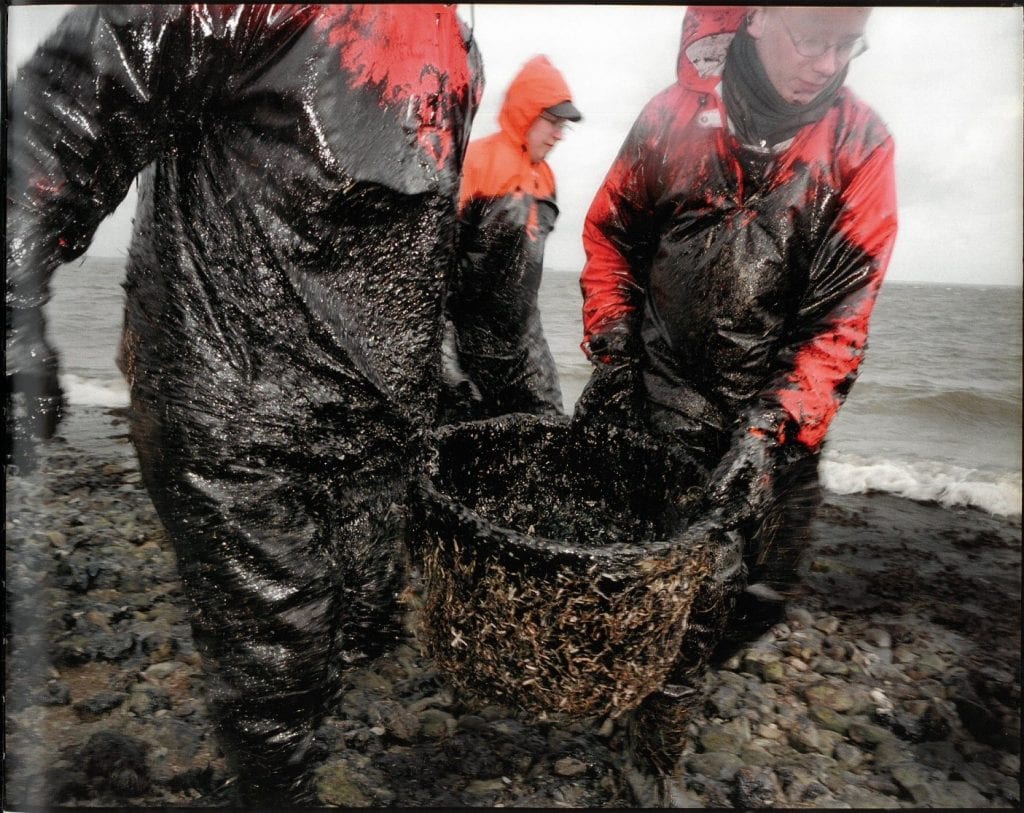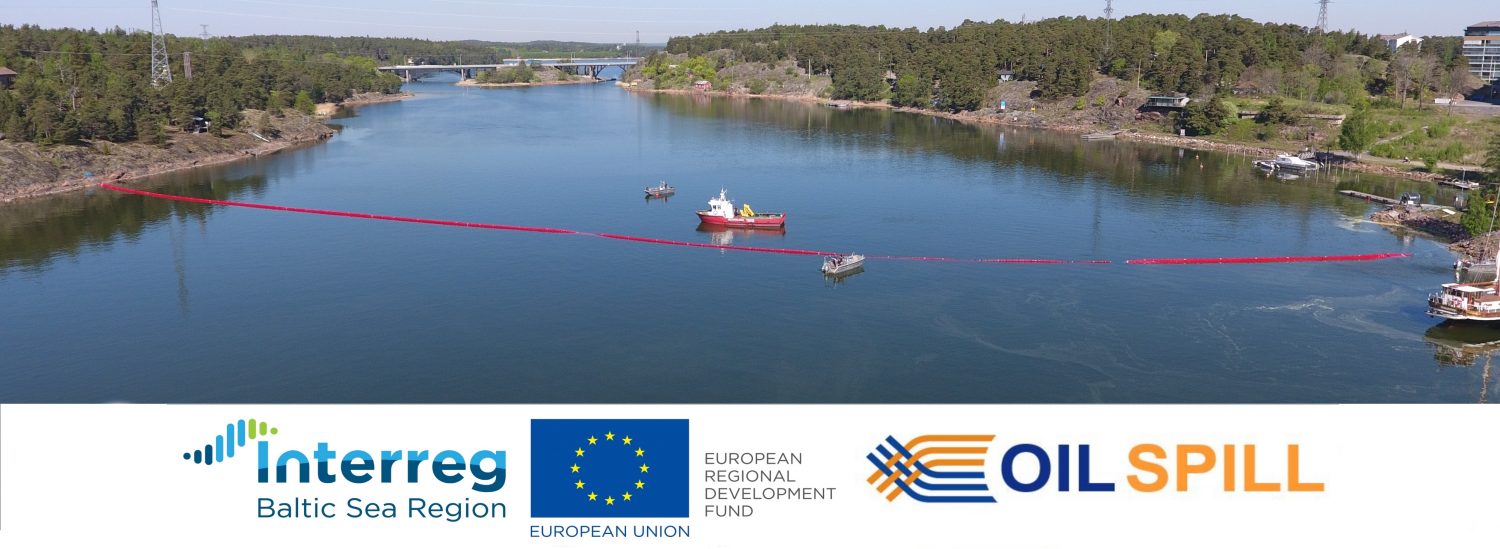The Baltic Carrier Accident in 2001 (2/4): How Does the Tube Fit?
Read Part 1/4 “What Happened and Who Were There” here.
Written by Kia Friis Petersen, Danish Civil Protection League

“The oil was so thick − like tar − that you could almost walk on it” – Peter Søe
It was not easy to remove the 2,350 tonnes of heavy fuel oil from the sea, shallow waters, or shores. Many people and an enormous number of wellingtons, waders, and shovels were needed in the operation.
In 2001, the national maritime environmental response in Denmark was comprised of the Navy, the Danish Emergency Management Agency (DEMA) and the Naval Home Guard. These three institutions were to handle all oil spills up to 5,000 tonnes at sea and in shallow waters and be able to collect 2,000 tonnes of oil in the first three days following the HELCOM recommendations (Danish Navy, 2008, p.5). However, the equipment in possession was only meant for oil that could be pumped. It turned out to be a greater issue, as they had to find other means to collect the oil.
The Danish Navy had oil recovery vessels. Two smaller ones of the sea-truck league called “Marie-Miljø” and “Mette-Miljø” with an operation radius of 1,000 nautical miles (DALO, 2017a) and two larger ones of the supply league called “Gunnar Thorsen” and “Gunnar Seidenfaden” with an operation radius of 3,500 nautical miles (DALO, 2017b). All four units were deployed in the operation along with two barges and a smaller standard vessel. The Naval Home Guard assisted with several smaller boats. DEMA had several skimmers that were initially used but failed to work due to the viscosity of the oil.
As the German and Danish environment units were not able to collect the oil around the Baltic Carrier, it drifted into the Belt of Groensund during the evening on 29 March. The next morning, it lay in pools on both the north and south side of the belt. Moreover, it had entered the shores and harbours in several places and spread over a distance of about 20 km along the belt. The most afflicted areas were Haarboelle Harbour, Bredemade Hage, and the bay between Faroe and Bogoe.
Problem-solving
Very quickly the operation’s commanders learned that a great part of their existing equipment was useless for collecting the oil on the sea and in shallow waters. To solve the problem, they had to think out of the box – and fast. The final solution was to engage private companies who owned diggers. These could grab or shovel up the oil in shallow waters, where the Navy’s units could not reach. Along with this, oil booms were placed to contain the oil in the areas that were already contaminated and to drag the oil closer to the diggers. At some of the incident sites, there were no roads or the foundation was very soft. In these places, it was not possible to use diggers or similar equipment. The personnel had to clean these areas manually with shovels. At one site, a digger got stuck in the sand and was flooded when the tide came in, as it had not been possible to get it out in time.
Where to put the oil?
As the oil collection operation proceeded, another issue occurred regarding the storage, transportation, and disposal of the collected oil and all the oil-contaminated materials. The Navy had a total storage of 2,000 tonnes on barrages and ships. But with almost 4,000 tonnes of oil and contaminated materials, it was far too little. Three barges were chartered along with two industrial beet barrels.
To move the oil from the barges to containers, it had to be heated to 80 degrees Celsius. To do so, a private entrepreneur was hired as none of the authorities had the equipment to do it on such scale. The containers were used as temporary storage before being transported to three different destruction companies in Denmark. However, the companies did not have the capacity to receive all the oil as quickly as it was collected. By end-June, over 2,000 tonnes of oil were still stored in a barge and the industrial beet barrels.
As an extra effort to collect all the oil from the accident, large containers were placed along the beaches after the official clean-up had ended. These containers were meant for civilians to use if they found oil remains on the beaches as more oil would wash up on the shores in the following period − either from the sea or as the oil that had been pushed into the sand by the heavy machines. The municipalities emptied the containers continuously, and the oil was transported to one of the destruction companies.
The part from the operation that made the greatest impression on Peter Søe, was the use of private entrepreneurs. And not just the fact that they were used, but also the difficulties it entailed:
“The first thing I did when I became Chief Fire Officer about a year after the incident, was to make a contract with a private company that handles entrepreneurs. Because I must admit that I didn’t know a thing about how to do it. But at the time of the incident, I had to do it anyway. And due to the lack of knowledge about handling private entrepreneurs, we had a lot of problems with some of them. For instance, several provided us with the eldest containers that were full of holes. So, we had to use a lot of time to insulate them. Another problem was that the different entrepreneurs wouldn’t carry the other’s containers when the oil had to be moved to the destruction companies.”
Can I order 1,000 pairs of wellingtons?
One of the biggest challenges during the operation was logistics. With up to 350 people working a day, there were many logistical issues that had to be solved: catering, personal protective equipment, working tools, handwash and toilets, shelter, accommodation, and transport. At many of the incident sites, toilet and handwash facilities were not installed, so the Technical Incident Management had to ensure it was done. The incident sites closed every evening and opened again early in the morning, as it was not possible to work during the night. Most of the personnel slept at the barracks at DEMA SJ. They were transported in busses to and from the operation sites every day, which had to be well-coordinated so that all teams were distributed correctly. The teams often worked twelve hours a day, and in all types of weather, so everything had to run as smooth as possible to avoid further delays.
At DEMA SJ, the operation centre was activated to handle the enormous amount of equipment and facilities that had to be distributed to all operation sites. Due to the texture and stickiness of the oil, a large part of the equipment was considered disposable after one use. This included both personal protective equipment and cleaning equipment.
“In 2001, it was not the hand sanitizer and face mask factories that were pushed to their limits. Instead, it was wader and wellington factories,” Peter Søe says. “We had to look several days ahead all the time, to make sure we didn’t run out of protective equipment when we used them as much as we did.”
As presented, the Baltic Carrier operation included many logistical challenges from its beginning to the end. However, through cooperation, planning, and a lot of creative thinking, these challenges were solved.
Sources:
- DEMA, Development unit (2001). Bekæmpelse af olieforureningen efter “Baltic Carrier” – En tværgående evaluering og erfaringsopsamling.
- Danish Navy (2008). Forsvarsministeriets kapacitetsundersøgelse vedrørende havmiljø.
- Peter Søe, Chief Fire Officer at Lolland-Falster Fire and Rescue Service (2020), interview.
- DALO (2017a): Miljøskib af Sea Truck-klassen.
- DALO (2017b): Miljøskib af Supply-klassen.

Leave a Reply